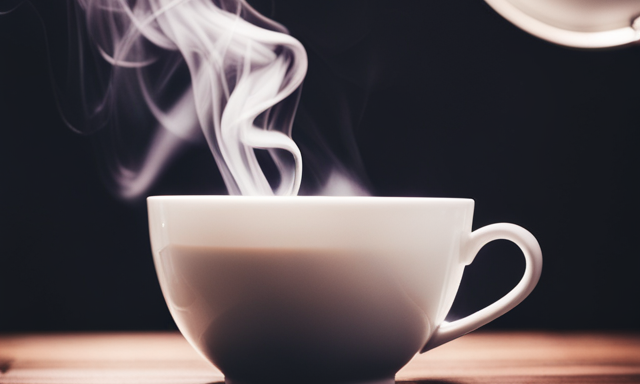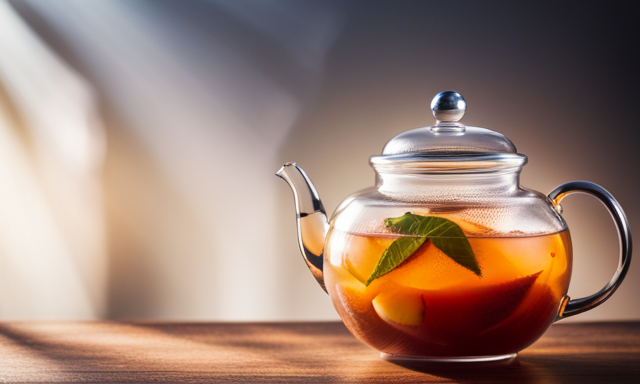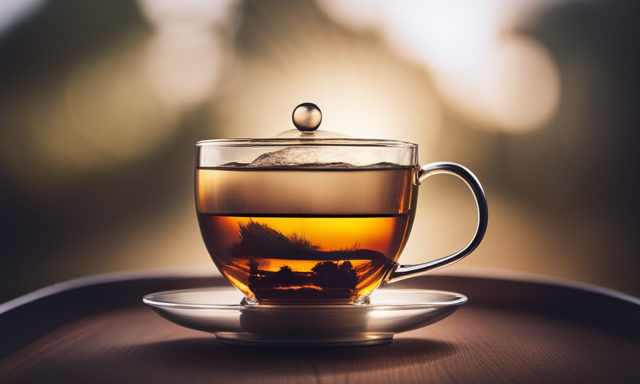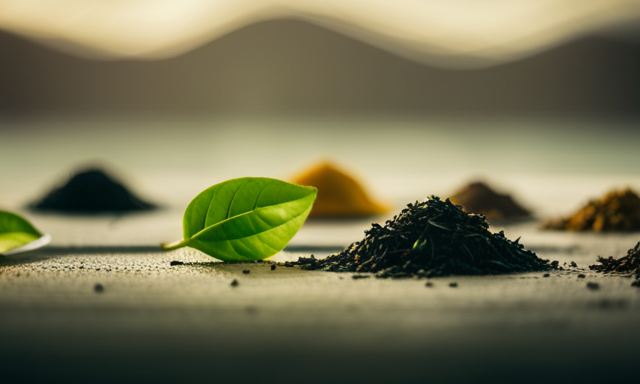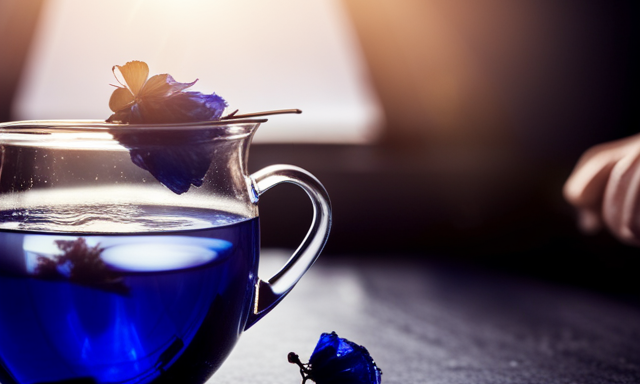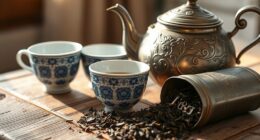Brewing loose oolong tea is like embarking on a blissful journey through a world of exquisite flavors and aromas. As a tea enthusiast, I have discovered that there is a certain art to brewing this remarkable tea that elevates the experience to new heights. In this article, I will guide you through the precise steps and techniques necessary to brew the perfect cup of loose oolong tea.
First, we will explore the different types of oolong tea and how to choose the right leaves for your desired taste.
Then, I will share with you the secrets to preparing your teapot and tea leaves, ensuring that every sip is infused with pure delight.
Next, we will delve into the science of heating water to the perfect temperature, a crucial step in unlocking the full potential of the oolong tea leaves.
Finally, we will explore the art of steeping the leaves and the proper methods for pouring and serving this heavenly elixir.
Get ready to embark on a tea brewing adventure that will leave your senses enraptured and your taste buds craving more. Let’s begin our journey into the world of loose oolong tea.
Key Takeaways
- Experiment with brewing times for varying intensity levels in oolong tea.
- Use filtered or spring water to avoid unwanted flavors from tap water.
- Properly store oolong tea in an airtight container away from light, moisture, and strong odors.
- Pair light and floral oolong with fresh fruits and roasted oolong with rich desserts for flavorful pairings.
Understanding the Different Types of Oolong Tea
To fully appreciate the nuances of loose oolong tea, you should familiarize yourself with the various types available. Each type offers its own distinct flavor profile. Oolong tea is known for its wide range of flavors, from light and floral to rich and roasted. These different flavors are a result of the varying levels of oxidation during processing.
Oolong tea originates from China and Taiwan. Each region produces teas that have their own unique characteristics. Chinese oolong teas are often lighter and more delicate, while Taiwanese oolong teas tend to be fuller-bodied and more complex.
By understanding the different oolong flavors and their origins, you can choose the right oolong tea leaves that suit your personal preferences.
Now, let’s dive into the next section about choosing the right oolong tea leaves.
Choosing the Right Oolong Tea Leaves
When selecting your oolong leaves, envision the vibrant hues of the rolling hills where they were harvested, allowing your senses to guide you towards the perfect blend.
Here are some factors to consider when choosing the right oolong tea leaves:
- Origin: Different regions produce oolong tea with distinct flavors. Taiwanese oolong offers a floral and fruity taste, while Chinese oolong has a more earthy and roasted profile.
- Oxidation Level: Oolong tea can range from lightly to heavily oxidized, resulting in varying flavors. Lighter oolongs have a delicate taste, while darker ones are more robust.
- Leaf Appearance: Look for tightly rolled leaves, which indicate quality. They should have a vibrant color and be intact without any breaks or tears.
- Aroma: Sniff the leaves to determine their fragrance. Floral, fruity, or nutty scents are desirable qualities.
- Quality Grade: Consider the grade of the tea leaves, with higher grades usually offering better flavor and aroma.
Choosing the right oolong tea leaves is essential to fully enjoy the benefits of drinking oolong tea. Now, let’s move on to preparing your teapot and tea leaves.
Preparing Your Teapot and Tea Leaves
Get ready to enhance your tea-drinking experience by preparing your teapot and selecting the perfect leaves for a delightful infusion. Teapot maintenance is essential to ensure the optimal flavor and aroma of your oolong tea. Start by thoroughly cleaning your teapot with warm water and a gentle cleanser, removing any residue or impurities that may affect the taste.
Additionally, regular descaling can prevent mineral build-up and extend the lifespan of your teapot. When it comes to tea leaf storage, keep them in an airtight container away from moisture, light, and strong odors. This will help preserve their freshness and prevent any flavor degradation.
Now that your teapot is ready and your tea leaves are stored properly, let’s move on to heating the water to the perfect temperature for brewing.
Heating the Water to the Perfect Temperature
Achieve tea nirvana by ensuring your water reaches the ideal temperature, transforming it into a bubbling hot spring of flavor and aroma. When brewing loose oolong tea, the perfect water temperature is crucial to unlocking its full potential. The temperature should be around 195 to 205 degrees Fahrenheit (90 to 96 degrees Celsius) for most oolong teas. Boiling water can scorch the delicate leaves and result in a bitter taste, while water that’s too cool may not fully extract the flavors.
Additionally, the importance of water quality can’t be overstated. Using filtered or spring water will enhance the taste of your oolong tea, as tap water may contain impurities that can affect the flavor.
Now that the water’s ready, let’s move on to steeping the oolong tea leaves and savoring the exquisite infusion they create.
Steeping the Oolong Tea Leaves
Now that the water’s at the perfect temperature, it’s time to let the oolong tea leaves steep, allowing their exquisite flavors and aromas to infuse into the hot water.
Steeping oolong tea is an art that requires a delicate balance of time and technique. There are various steeping techniques to consider, depending on the type of oolong tea and your personal preference.
For a lighter, more delicate flavor, a shorter steeping time of around 2-3 minutes is recommended. If you prefer a stronger, bolder taste, you can extend the steeping time to 4-5 minutes. It’s important to be mindful of the recommended steeping times to ensure that the tea doesn’t become bitter or overly astringent.
Timing the steeping process is crucial to achieving the perfect cup of oolong tea, so let’s explore this in the next section about monitoring the steeping time.
Timing the Steeping Process
Make sure to carefully monitor the steeping time to ensure that you extract the perfect balance of flavors and avoid any bitterness or astringency in your cup of oolong tea. Steeping time is a crucial factor in achieving the desired taste and aroma. The length of time you steep the tea will depend on personal preference and the specific type of oolong tea you are brewing. To help you gauge the ideal steeping time, refer to the following table:
| Type of Oolong Tea | Steeping Time |
|---|---|
| Light Oolong | 2-3 minutes |
| Medium Oolong | 3-4 minutes |
| Dark Oolong | 4-5 minutes |
| Aged Oolong | 5-6 minutes |
Remember, when it comes to brewing oolong tea, patience is key. Take the time to carefully steep the tea and savor the process. Once the steeping is complete, it’s time to move on to pouring and serving the oolong tea, ensuring an enjoyable tea-drinking experience.
Pouring and Serving the Oolong Tea
When it’s time to pour and serve your perfectly steeped oolong tea, remember to slow down and savor the moment. Here are some serving techniques to enhance your tea experience:
-
Use a teapot with a strainer: Pour the steeped tea from the brewing vessel into a teapot with a built-in strainer. This will separate the leaves from the tea, ensuring a smooth and clean pour.
-
Preheat your teacups: Warm your teacups by rinsing them with hot water before pouring the tea. This’ll help maintain the optimal temperature and preserve the flavors.
-
Serve in small cups: Oolong tea is best enjoyed in small, porcelain cups. This allows you to appreciate the aroma and taste with each sip.
-
Take note of flavor profiles: As you serve the tea, pay attention to the unique flavor profiles of different oolong teas. Notice the varying levels of sweetness, floral notes, and earthy undertones.
As you become more familiar with serving techniques and flavor profiles, you can start experimenting with different brewing techniques to further enhance your oolong tea experience.
Experimenting with Different Brewing Techniques
If you want to elevate your oolong tea experience, try exploring various brewing techniques to unlock a world of diverse flavors and aromas. Imagine the possibilities of creating a unique tea profile with just a few adjustments.
One key aspect to experiment with is the brewing time. By varying the steeping duration, you can achieve different levels of intensity in your tea. For a lighter and more delicate brew, steep the oolong leaves for around 2 minutes. If you prefer a stronger flavor, go for a longer brewing time of 4-5 minutes.
Additionally, the quality of water used can greatly impact the taste of your oolong tea. Opt for filtered or spring water to avoid any unwanted flavors from tap water.
Now, let’s dive into the next section and discover how to properly store and preserve oolong tea leaves without compromising their freshness.
Storing and Preserving Oolong Tea Leaves
Discover the secrets to keeping your oolong tea leaves fresh and flavorful for longer. When it comes to storing techniques, preserving freshness is key.
To maintain the quality of your oolong tea, it’s important to store it properly. Start by keeping the tea leaves in an airtight container, away from light, moisture, and strong odors. This will help prevent the tea from absorbing any unwanted flavors and maintain its natural aroma.
Additionally, store the tea in a cool and dry place. It’s recommended to avoid storing oolong tea in the refrigerator, as the moisture can cause the leaves to deteriorate. Temperature and humidity can affect its freshness.
By following these storing techniques, you can ensure that your oolong tea remains delicious and enjoyable for a longer period of time.
Now, let’s explore how to enhance your oolong tea experience with pairings and accessories.
Enhancing Your Oolong Tea Experience with Pairings and Accessories
Elevate your oolong tea experience by exploring a world of flavorful pairings and indulging in luxurious accessories that will enhance your enjoyment. To truly enhance the flavors of your oolong tea, consider pairing it with complementary foods. For a light and floral oolong, try pairing it with fresh fruits like peaches or lychee. If you prefer a more roasted oolong, rich desserts like chocolate or almond cake will complement the flavors perfectly. Additionally, incorporating essential tea accessories can elevate your brewing experience. A traditional gaiwan or a clay teapot can enhance the flavors and aromas of the tea. A tea infuser or a tea ball can make the brewing process more convenient. Don’t forget to use a tea timer or a thermometer to ensure the perfect brew every time. By exploring pairing suggestions and investing in essential tea accessories, you can truly enhance your oolong tea experience.
| Pairing Suggestions | Essential Tea Accessories |
|---|---|
| Fresh Fruits | Traditional Gaiwan |
| Rich Desserts | Clay Teapot |
| Tea Infuser/Tea Ball | |
| Tea Timer/Thermometer |
Frequently Asked Questions
Can I use any type of water to brew oolong tea?
You can use different types of water to brew oolong tea, but the water temperature is crucial to achieve the desired taste. The temperature affects the tea’s flavor profile, so it’s important to experiment and find the perfect balance for your preference.
How long does oolong tea stay fresh after opening the package?
Oolong tea stays fresh for about 6-12 months after opening, depending on how it’s stored. To extend its shelf life, store it in an airtight container away from light, moisture, and strong odors.
Can I reuse oolong tea leaves for multiple infusions?
Yes, you can definitely reuse oolong tea leaves for multiple infusions. This not only allows you to enjoy the rich flavor and aroma multiple times, but also maximizes the health benefits of oolong tea.
Does the size of the tea leaves affect the flavor of the brewed oolong tea?
The size of the tea leaves does affect the flavor of brewed oolong tea. Smaller leaves have a stronger, more concentrated flavor, while larger leaves are milder and more delicate. Brewing techniques vary for different varieties.
Are there any health benefits associated with drinking oolong tea?
Drinking oolong tea may have potential health benefits. Research suggests it could aid in weight loss and promote heart health. However, more studies are needed to fully understand the extent of these benefits.
Conclusion
In conclusion, brewing loose oolong tea is like embarking on a sensory journey through the rolling hills of flavor. It requires patience, precision, and a touch of artistry. By understanding the different types of oolong tea and choosing the right leaves, you can unlock a world of aromatic delights.
From preparing your teapot to steeping at the perfect temperature, every step is crucial in extracting the tea’s essence. So pour yourself a cup, savor the moment, and let the rich, complex flavors transport you to a state of blissful tranquility. Cheers to the art of brewing oolong tea!

